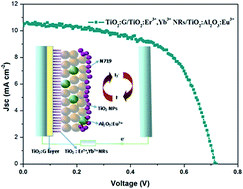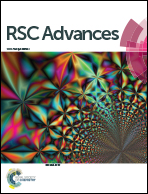Improving the photovoltaic performance of dye sensitized solar cells based on a hierarchical structure with up/down converters
Abstract
A hierarchical structure composed of porous TiO2:Al2O3:Eu3+ nanoparticles (NPs) and vertically grown one-dimensional TiO2:Er3+,Yb3+ nanorods (NRs) on fluorine doped tin oxide (FTO) substrates coated with a TiO2:graphene (G) seed layer was investigated for use in photoanodes for dye sensitized solar cells (DSSCs). The DSSCs assembled with this hierarchical structure exhibit an outstanding power conversion efficiency of 4.58%, which is superior to that of the devices based on pure TiO2. This high performance can be attributed to the spectrum modifications achieved by utilizing the upconversion (UC) material TiO2:Er3+,Yb3+ and the downconversion (DC) material Al2O3:Eu3+, which facilitate the light harvesting of solar cells via converting near infrared (NIR) and ultraviolet (UV) radiation to visible emission, respectively. Moreover, the TiO2:G layer provides faster electron transport from TiO2 to FTO for the high carrier mobility of G. Moreover, the one-dimensional nanorod structure can offer direct electrical pathways for photogenerated electrons as well as enhance the light scattering capabilities of photoanodes. This study indicates that the TiO2:G/TiO2:Er3+,Yb3+ NRs/TiO2:Al2O3:Eu3+ hierarchical structure has the potential to improve the performance of DSSCs.


 Please wait while we load your content...
Please wait while we load your content...